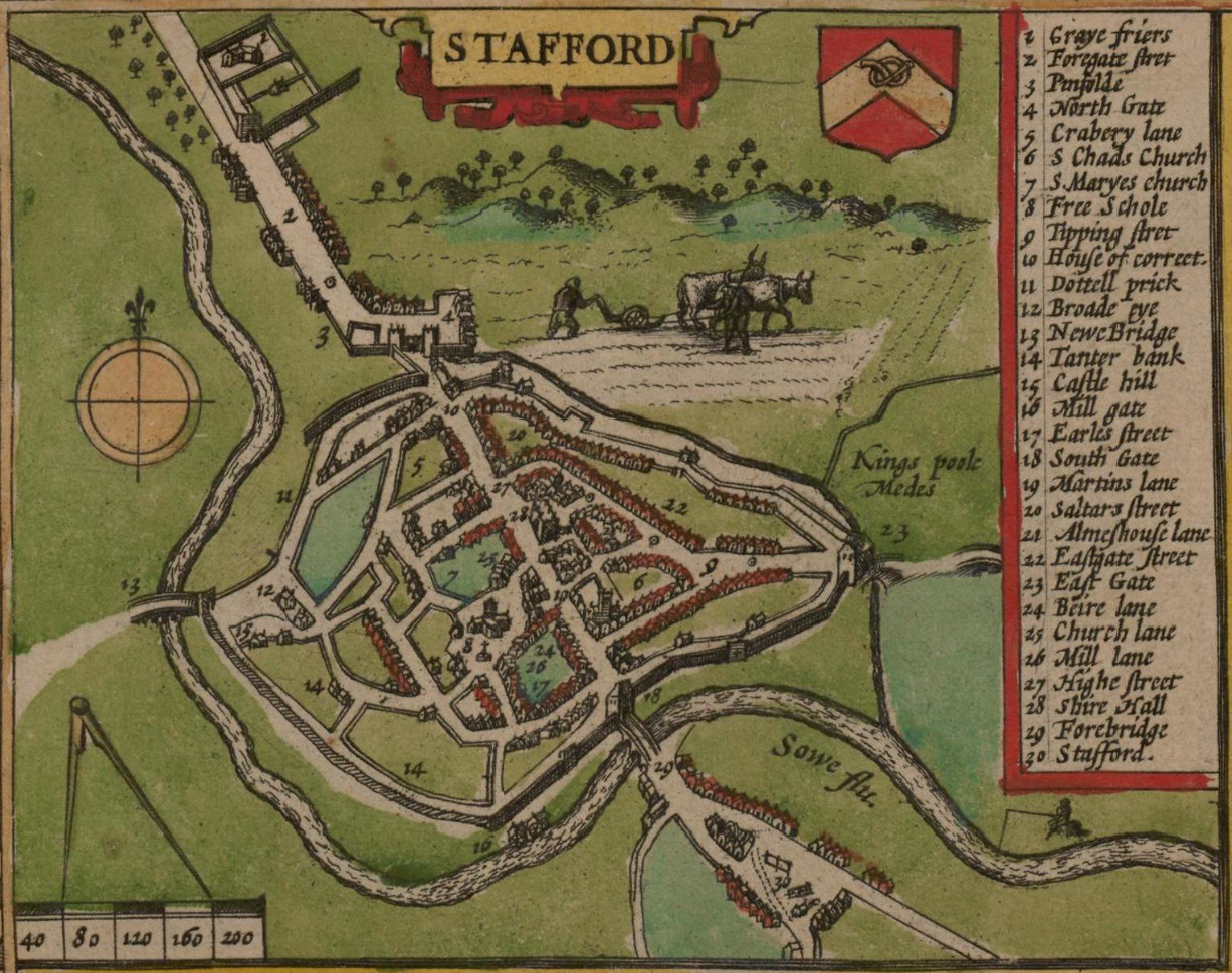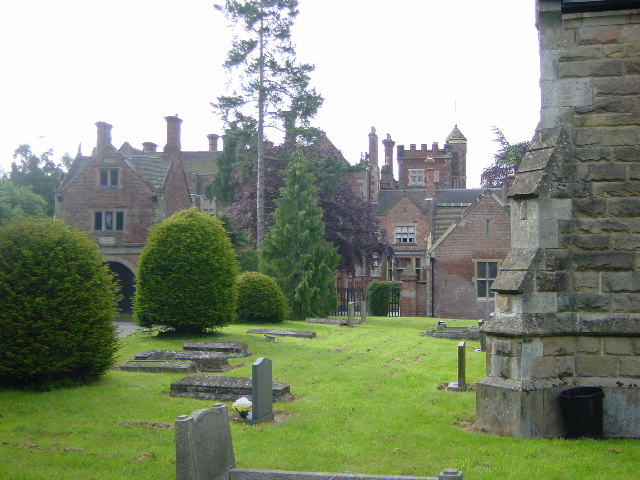|
Coton Clanford
Coton Clanford is a small dispersed Staffordshire village lying in gently rolling countryside due west of Stafford, England, and southeast of Seighford. The name of the village is sometimes hyphenated to Coton-Clanford, appearing this way on some cottage names locally. The population for this village as taken at the 2011 census can be found under Seighford. It lies midway between the B5405 road, 1½ miles to the north and the A518 1½ miles to the south. The village has no shop, public house or church, comprising only a few scattered houses and cottages, several dairy farms and a long unused 19th-century chapel. History and amenities The name derives from "(at the) cottages" (Coton) and, probably, "clean, unencumbered ford" (Clanford, added later). The Primitive Methodist chapel was built in 1884, with the foundation stone laid on 30 October 1884. The chapel records 1891–1907, Coton Clanford Society records and Methodist chapel minute books, 1903–1929, are stored at S ... [...More Info...] [...Related Items...] OR: [Wikipedia] [Google] [Baidu] |
Staffordshire
Staffordshire (; postal abbreviation ''Staffs''.) is a Ceremonial counties of England, ceremonial county in the West Midlands (region), West Midlands of England. It borders Cheshire to the north-west, Derbyshire and Leicestershire to the east, Warwickshire to the south-east, the West Midlands (county), West Midlands county and Worcestershire to the south, and Shropshire to the west. The largest settlement is the city of Stoke-on-Trent. The county has an area of and a population of 1,131,052. Stoke-on-Trent is located in the north and is immediately adjacent to the town of Newcastle-under-Lyme. Stafford is in the centre of the county, Burton upon Trent in the east, and the city of Lichfield and Tamworth, Staffordshire, Tamworth in the south-east. For local government purposes Staffordshire comprises a non-metropolitan county, with nine districts, and the Unitary authorities of England, unitary authority area of Stoke-on-Trent. The county Historic counties of England, historical ... [...More Info...] [...Related Items...] OR: [Wikipedia] [Google] [Baidu] |
Stafford
Stafford () is a market town and the county town of Staffordshire, England. It is located about south of Stoke-on-Trent, north of Wolverhampton, and northwest of Birmingham. The town had a population of 71,673 at the 2021–2022 United Kingdom censuses, 2021 census, and is the main settlement within the larger Borough of Stafford, which had a population of 136,837 in 2021. Stafford has Anglo-Saxons, Anglo-Saxon roots, being founded in 913, when Æthelflæd, List of monarchs of Mercia, Lady of the Mercians founded a defensive burh, it became the county town of Staffordshire soon after. Stafford became an important market town in the Middle Ages, and later grew into an important industrial town due to the proliferation of shoemaking, engineering and electrical industries. History Ancient Prehistoric finds suggest scattered settlements in the area, whilst south-west of the town lies an British Iron Age, Iron Age hill fort at Berry Ring. There is also evidence of Roman Brit ... [...More Info...] [...Related Items...] OR: [Wikipedia] [Google] [Baidu] |
Seighford
Seighford ( ) is a village and civil parish about west of Stafford in Staffordshire, England. The population of this civil parish at the 2011 census was 1,793. The ford across a small stream is the origin of the village's toponym. The village has a red brick Church of England parish church, St Chad's, and Seighford Hall, a 16th-century Tudor mansion. History William White's ''History, Gazetteer and Directory of Staffordshire'' (1851) described the village: Seighford is a scattered village above a small brook which flows east from Latford pool to the River Sow. Its parish contains the hamlets of Aston and Derrington, from one to one and a half miles east, Coton Clanford, one mile south, and Great and Little Bridgeford, three and a half miles north-east of Stafford. Doxey, east of the M6 motorway, became a separate civil parish in 2005. It forms a highly cultivated district, containing 803 inhabitants, and 3,830 acre of land. Francis Eld, Esq, is lord of the manor, and own ... [...More Info...] [...Related Items...] OR: [Wikipedia] [Google] [Baidu] |
United Kingdom Census 2011
A Census in the United Kingdom, census of the population of the United Kingdom is taken every ten years. The 2011 census was held in all countries of the UK on 27 March 2011. It was the first UK census which could be completed online via the Internet. The Office for National Statistics (ONS) is responsible for the census in England and Wales, the General Register Office for Scotland (GROS) is responsible for the census in Scotland, and the Northern Ireland Statistics and Research Agency (NISRA) is responsible for the census in Northern Ireland. The Office for National Statistics is the executive office of the UK Statistics Authority, a non-ministerial department formed in 2008 and which reports directly to Parliament. ONS is the UK Government's single largest statistical producer of independent statistics on the UK's economy and society, used to assist the planning and allocation of resources, policy-making and decision-making. ONS designs, manages and runs the census in England an ... [...More Info...] [...Related Items...] OR: [Wikipedia] [Google] [Baidu] |
B5405 Road
B roads are numbered routes in Great Britain of lesser importance than A roads. See the article Great Britain road numbering scheme In Great Britain, there is a numbering scheme used to Categorization, classify and identify all roads. Each road is given a single letter (representing a category) and a subsequent number (between one and four digits). Though this scheme was in ... for the rationale behind the numbers allocated. Zone 5 (3 digits) B5000 to B5099 B5100 to B5199 B5200 to B5299 B5300 to B5399 B5400 to B5499 B5500 to B5999 References {{DEFAULTSORT:B Roads In Zone 5 Of The Great Britain Numbering Scheme 5 5 ... [...More Info...] [...Related Items...] OR: [Wikipedia] [Google] [Baidu] |
A518 Road
List of A roads in zone 5 in Great Britain starting north/east of the A5, west of the A6, south of the Solway Firth/Eden Estuary The River Eden is a river in Fife in Scotland, and is one of Fife's two principal rivers, along with the Leven. It is nearly long and has a fall of around . Course The source of the Eden is either at the confluence of the two burns (streams ... (roads beginning with 5). Single- and double-digit roads Three-digit roads Four-digit roads (50xx) Four-digit roads (51xx) Four-digit roads (52xx) Four-digit roads (53xx to 57xx) References {{DEFAULTSORT:A Roads In Zone 5 Of The Great Britain Numbering Scheme 5 5 ... [...More Info...] [...Related Items...] OR: [Wikipedia] [Google] [Baidu] |
Primitive Methodist Church
The Primitive Methodist Church is a Christian denomination within the holiness movement. Originating in early 19th-century England as a Christian revival, revivalist movement within Methodism, it was heavily influenced by American evangelist Lorenzo Dow (1777–1834), whose visits inspired a return to fervent, open-air preaching. In the United States, the Primitive Methodist Church had eighty-three parishes and 8,487 members in 1996. In Great Britain and Australia, the Primitive Methodist Church merged with other denominations, to form the Methodist Church of Great Britain in 1932 and the Methodist Church of Australasia in 1901. (The latter subsequently merged into the Uniting Church in Australia in 1977.) History United Kingdom The leaders who originated Primitive Methodism were attempting to restore a spirit of Christian revival, revivalism as they felt was found in the ministry of John Wesley, with no intent of forming a new church. The leaders were Hugh Bourne (1772–1852) ... [...More Info...] [...Related Items...] OR: [Wikipedia] [Google] [Baidu] |
Ranton, Staffordshire
Ranton is a hamlet and civil parish In England, a civil parish is a type of administrative parish used for local government. It is a territorial designation which is the lowest tier of local government. Civil parishes can trace their origin to the ancient system of parishes, w ... in Staffordshire, England, situated west of Stafford, east of Woodseaves and northeast of Gnosall. The population taken at the United Kingdom Census 2011, 2011 census was 382. As of 2013, both public houses that once operated in Ranton were bought and subsequently removed from operation. Due to this, Ranton is now listed as a hamlet. History Ranton is listed under the Pirehill Hundred section of Domesday Book. There is debate as to how the name Ranton was spelt prior to the 18th century, possibilities include 'Ronton', 'Rantone' (as named in Domesday Book in 1086) and 'Rantun' (rarely used). All Saints church, Ranton All Saints' Day, All Saints church, Ranton, is a small ancient structure, ... [...More Info...] [...Related Items...] OR: [Wikipedia] [Google] [Baidu] |
Doxey
Doxey is a village and civil parish in the borough of Stafford in Staffordshire, England. It is a north-western suburb of Stafford. The village became a civil parish on 1 April 2005. There is some uncertainty about the origin of the name Doxey but it seems that it was originally Dokesei (This may be "Ducks Island" - a reference to the fact that the centre of Doxey would have been surrounded by marsh). In the Domesday Book it is spelt Dochesig. Transport links ;Buses Doxey is served by the Number 6 Arriva Midlands bus service between Doxey and Stafford town centre. It runs about every 30 minutes. Current timetables (click to view)Arriva Routes & Timetables ;Trains [...More Info...] [...Related Items...] OR: [Wikipedia] [Google] [Baidu] |
William Wollaston
William Wollaston (; 26 March 165929 October 1724) was an English school teacher, Church of England priest, scholar of Latin, Greek, and Hebrew, theologian, and a major Enlightenment era English philosopher. He is remembered today for one book, which he completed two years before his death: '' The Religion of Nature Delineated''. He led a cloistered life, but in terms of eighteenth-century philosophy and the concept of natural religion, he is ranked with British Enlightenment philosophers such as Locke, Berkeley, and Hume. Wollaston's work contributed to the development of two important intellectual schools: British Deism, and " the pursuit of happiness" moral philosophy of American Practical Idealism, a phrase which appears in the United States Declaration of Independence. Life Wollaston was born at Coton Clanford in Staffordshire, on 26 March 1659. He was born to a family long-established in Staffordshire, and was distantly related to Sir John Wollaston, the Alderman an ... [...More Info...] [...Related Items...] OR: [Wikipedia] [Google] [Baidu] |
Encyclopædia Britannica
The is a general knowledge, general-knowledge English-language encyclopaedia. It has been published by Encyclopædia Britannica, Inc. since 1768, although the company has changed ownership seven times. The 2010 version of the 15th edition, which spans 32 volumes and 32,640 pages, was the last printed edition. Since 2016, it has been published exclusively as an online encyclopedia, online encyclopaedia. Printed for 244 years, the ''Britannica'' was the longest-running in-print encyclopaedia in the English language. It was first published between 1768 and 1771 in Edinburgh, Scotland, in three volumes. The encyclopaedia grew in size; the second edition was 10 volumes, and by its fourth edition (1801–1810), it had expanded to 20 volumes. Its rising stature as a scholarly work helped recruit eminent contributors, and the 9th (1875–1889) and Encyclopædia Britannica Eleventh Edition, 11th editions (1911) are landmark encyclopaedias for scholarship and literary ... [...More Info...] [...Related Items...] OR: [Wikipedia] [Google] [Baidu] |


